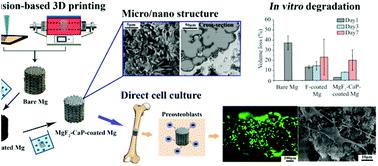当前位置:
X-MOL 学术
›
Biomater. Sci.
›
论文详情
Our official English website, www.x-mol.net, welcomes your
feedback! (Note: you will need to create a separate account there.)
Extrusion-based 3D printed magnesium scaffolds with multifunctional MgF2 and MgF2–CaP coatings
Biomaterials Science ( IF 5.8 ) Pub Date : 2021-09-01 , DOI: 10.1039/d1bm01238j J Dong 1 , N Tümer 1 , N E Putra 1 , J Zhu 2 , Y Li 3 , M A Leeflang 1 , P Taheri 2 , L E Fratila-Apachitei 1 , J M C Mol 2 , A A Zadpoor 1 , J Zhou 1
Biomaterials Science ( IF 5.8 ) Pub Date : 2021-09-01 , DOI: 10.1039/d1bm01238j J Dong 1 , N Tümer 1 , N E Putra 1 , J Zhu 2 , Y Li 3 , M A Leeflang 1 , P Taheri 2 , L E Fratila-Apachitei 1 , J M C Mol 2 , A A Zadpoor 1 , J Zhou 1
Affiliation

|
Additively manufactured (AM) biodegradable magnesium (Mg) scaffolds with precisely controlled and fully interconnected porous structures offer unprecedented potential as temporary bone substitutes and for bone regeneration in critical-sized bone defects. However, current attempts to apply AM techniques, mainly powder bed fusion AM, for the preparation of Mg scaffolds, have encountered some crucial difficulties related to safety in AM operations and severe oxidation during AM processes. To avoid these difficulties, extrusion-based 3D printing has been recently developed to prepare porous Mg scaffolds with highly interconnected structures. However, limited bioactivity and a too high rate of biodegradation remain the major challenges that need to be addressed. Here, we present a new generation of extrusion-based 3D printed porous Mg scaffolds that are coated with MgF2 and MgF2–CaP to improve their corrosion resistance and biocompatibility, thereby bringing the AM scaffolds closer to meeting the clinical requirements for bone substitutes. The mechanical properties, in vitro biodegradation behavior, electrochemical response, and biocompatibility of the 3D printed Mg scaffolds with a macroporosity of 55% and a strut density of 92% were evaluated. Furthermore, comparisons were made between the bare scaffolds and the scaffolds with coatings. The coating not only covered the struts but also infiltrated the struts through micropores, resulting in decreases in both macro- and micro-porosity. The bare Mg scaffolds exhibited poor corrosion resistance due to the highly interconnected porous structure, while the MgF2–CaP coatings remarkably improved the corrosion resistance, lowering the biodegradation rate of the scaffolds down to 0.2 mm y−1. The compressive mechanical properties of the bare and coated Mg scaffolds before and during in vitro immersion tests for up to 7 days were both in the range of the values reported for the trabecular bone. Moreover, direct culture of MC3T3-E1 preosteoblasts on the coated Mg scaffolds confirmed their good biocompatibility. Overall, this study clearly demonstrated the great potential of MgF2–CaP coated porous Mg prepared by extrusion-based 3D printing for further development as a bone substitute.
中文翻译:

具有多功能 MgF2 和 MgF2–CaP 涂层的挤压型 3D 打印镁支架
具有精确控制和完全互连的多孔结构的增材制造 (AM) 可生物降解镁 (Mg) 支架提供了前所未有的潜力,作为临时骨替代品和关键尺寸骨缺损的骨再生。然而,目前应用增材制造技术(主要是粉末床熔融增材制造)来制备镁支架的尝试遇到了一些与增材制造操作的安全性和增材制造过程中的严重氧化相关的关键困难。为了避免这些困难,最近开发了基于挤压的 3D 打印来制备具有高度互连结构的多孔镁支架。然而,有限的生物活性和过高的生物降解率仍然是需要解决的主要挑战。这里,2和 MgF 2 –CaP 以提高其耐腐蚀性和生物相容性,从而使 AM 支架更接近于满足骨替代物的临床要求。评估了具有 55% 大孔隙率和 92% 支柱密度的 3D 打印镁支架的机械性能、体外生物降解行为、电化学响应和生物相容性。此外,在裸支架和带有涂层的支架之间进行了比较。涂层不仅覆盖了支柱,而且还通过微孔渗入支柱,导致宏观和微孔率降低。由于高度互连的多孔结构,裸镁支架表现出较差的耐腐蚀性,而 MgF 2–CaP 涂层显着提高了耐腐蚀性,将支架的生物降解率降低到 0.2 mm y -1。在长达 7 天的体外浸泡测试之前和期间,裸露和涂层镁支架的压缩力学性能均在报告的骨小梁值范围内。此外,在包被的镁支架上直接培养 MC3T3-E1 前成骨细胞证实了它们良好的生物相容性。总体而言,这项研究清楚地证明了通过基于挤压的 3D 打印制备的 MgF 2 -CaP 涂层多孔镁作为骨替代品的进一步开发潜力。
更新日期:2021-09-22
中文翻译:

具有多功能 MgF2 和 MgF2–CaP 涂层的挤压型 3D 打印镁支架
具有精确控制和完全互连的多孔结构的增材制造 (AM) 可生物降解镁 (Mg) 支架提供了前所未有的潜力,作为临时骨替代品和关键尺寸骨缺损的骨再生。然而,目前应用增材制造技术(主要是粉末床熔融增材制造)来制备镁支架的尝试遇到了一些与增材制造操作的安全性和增材制造过程中的严重氧化相关的关键困难。为了避免这些困难,最近开发了基于挤压的 3D 打印来制备具有高度互连结构的多孔镁支架。然而,有限的生物活性和过高的生物降解率仍然是需要解决的主要挑战。这里,2和 MgF 2 –CaP 以提高其耐腐蚀性和生物相容性,从而使 AM 支架更接近于满足骨替代物的临床要求。评估了具有 55% 大孔隙率和 92% 支柱密度的 3D 打印镁支架的机械性能、体外生物降解行为、电化学响应和生物相容性。此外,在裸支架和带有涂层的支架之间进行了比较。涂层不仅覆盖了支柱,而且还通过微孔渗入支柱,导致宏观和微孔率降低。由于高度互连的多孔结构,裸镁支架表现出较差的耐腐蚀性,而 MgF 2–CaP 涂层显着提高了耐腐蚀性,将支架的生物降解率降低到 0.2 mm y -1。在长达 7 天的体外浸泡测试之前和期间,裸露和涂层镁支架的压缩力学性能均在报告的骨小梁值范围内。此外,在包被的镁支架上直接培养 MC3T3-E1 前成骨细胞证实了它们良好的生物相容性。总体而言,这项研究清楚地证明了通过基于挤压的 3D 打印制备的 MgF 2 -CaP 涂层多孔镁作为骨替代品的进一步开发潜力。











































 京公网安备 11010802027423号
京公网安备 11010802027423号